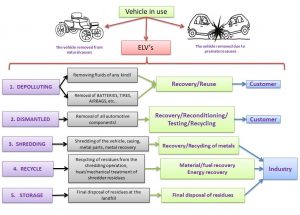Lesson 2 – ELVs Recycling Operations
Welcome to second lesson of our online course on end-of-life vehicle recycling operations. In this course, we will explore a variety of phases required to ELVs recycling that allow recovery of large amounts of metals for industry.
With the development of technology, there have also been ingenious new ways to use different materials in the construction of cars, and through recycling, these resources can be recovered and reused to reduce pollution and reduce the carbon footprint generated globally.
Vehicles fall into the ELVs category for two reasons:
- they reach a certain “age“, they practically become “old“, they are called “natural end-of-life vehicles“;
- or they suffered accidents as a result of which they could no longer be recovered, the latter bearing the name of “prematurely retired vehicles“.
They contain WEEE and are known as an important source of secondary raw materials. Thus, the automotive sector becomes a relevant source of WEEE, given the large presence of electronic components in cars.
End-of-life vehicle recycling operations involve the processing and preparation of used vehicles for disposal, which requires five main activities, as shown in the following figure:
- For a vehicle at the end of its life cycle, the first step is to hand it over to an authorized dismantler. Thus, the last owner of the used vehicle will deliver it to an authorized dismantler, who, after checking the vehicle, will issue a Certificate of Destruction necessary for the cancellation of the vehicle.
- The first step in ELV’s recycling is Vehicle Decontamination and Pretreatment which involves removing all fluids, fuel and any potentially hazardous components such as batteries and airbags. This includes: engine oil, transmission oil, brake fluid, as well as coolant from the air conditioning system.
- Then Disassembly and removal of all recyclable parts such as tires, catalytic converter, etc., as well as removing the hybrid battery for electric vehicles. Materials such as plastic or glass are stored separately for recycling.
- Storage of materials harmful to the environment with a view to separate collection and subsequent delivery to companies specialized in their recycling, to be recovered or disposed of.
- Shredding or ASR, the pre-treated parts are sent to a shredder (Shredder) that cuts the end-of-life vehicle into pieces in order to sort it into different fragments for further recycling or recovery.
- Post-shredder Technologies of Material Sorting, where previously cut materials are further processed through various technological sorting processes (magnetic separation, eddy current, flotation) to obtain new material fragments that can be used as secondary raw material with value, with a view to re-introduction on the market or in the industry.
- Recycling / Recovery / Storage. The residues obtained from the sorting of materials can be recycled (as a substitute for blast furnace coal, as a dewatering agent for conditioning liquid sewage residues) or can be recovered and introduced into the cement industry.
This chain of technological processes leads to a 90% recovery of the vehicle drastically reducing the amount of waste left for the landfill.